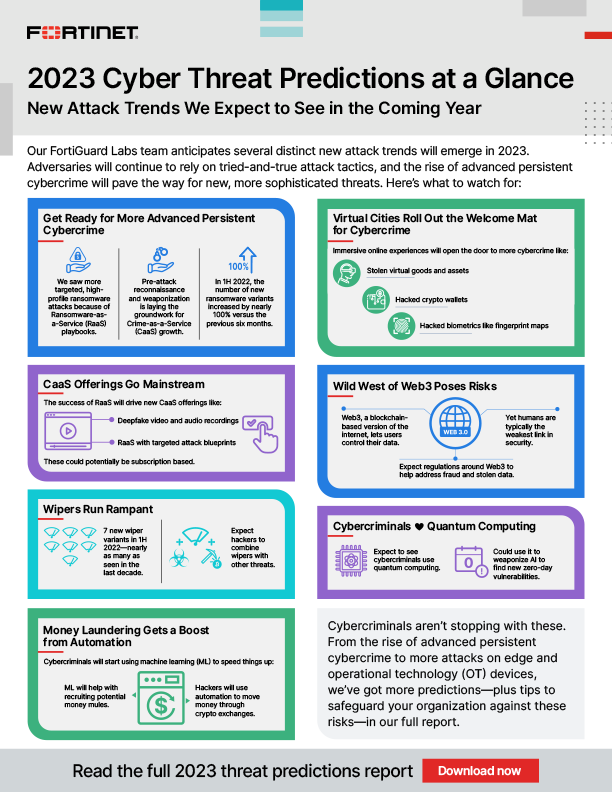Fortinet, a global leader in broad, integrated and automated cybersecurity solutions, has unveiled predictions from the FortiGuard Labs global threat intelligence and research team about the cyberthreat landscape for the next 12 months and beyond.

From quickly evolving Cybercrime-as-a-Service (CaaS)-fuelled attacks to new exploits on non-traditional targets like edge devices or online worlds, the volume, variety and scale of cyberthreats will keep security teams on high alert in 2023 and beyond.
“In 2023, cybercriminals will continue to use tried-and-true attack tactics, particularly those that are easy to execute and help them achieve a quick payday,” said Rashish Pandey, Vice President of Marketing and Communications, Fortinet Asia. “In addition, we can also expect several new attack trends leveraging deepfakes, Metaverse, Web3 and mixed reality (MR) technologies to increase.
“To effectively defend against these attacks, organisations need to understand cybercriminals better, what motivates them, their tools and tactics and how they act,” said Pandey. “However, given the cyber skills talent shortage, organisations can consider adopting managed services to support the integration of security into the network and deploying automated response tools in addition to having a cybersecurity mesh platform.”
“The acceleration of Digital Transformation, including the transition to the cloud, the rapid adoption of IoT and applications, is replacing the traditional network,” said Nirav Shah, Vice President of Products at Fortinet. “The corporate network must keep up with these remote connectivity demands and maintain consistent security everywhere.
“To do that, businesses must tightly integrate their network infrastructure and security architecture, enabling the network to scale and change without compromising security,” said Shah. “This next-generation approach is essential for effectively defending today’s highly dynamic environments, providing consistent enforcement across today’s highly flexible perimeters and weaving security deep into the network.”
Key findings
- Success of RaaS is a preview of what is to come with CaaS
- Reconnaissance-as-a-Service models could make attacks more effective
- Money laundering gets a boost from automation to create LaaS
- Virtual cities and online worlds are new attack surfaces to fuel cybercrime
- Commoditisation of wiper malware will enable more destructive attacks
Using AI-powered inline sandboxing is a good starting point to protect against sophisticated ransomware and wiper malware threats. It allows real-time protection against evolving attacks because it can ensure only benign files will be delivered to endpoints if integrated with a cybersecurity platform.
What these attack trends mean for cybersecurity professionals
The world of cybercrime and the attack methods of cyber adversaries, in general, continue to scale at great speed. The good news is that many of the tactics they are using to execute these attacks are familiar, which better positions security teams to protect against them. Security solutions should be enhanced with Machine Learning (ML) and Artificial Intelligence (AI) so they can detect attack patterns and stop threats in real-time. However, a collection of point security solutions is not effective in today’s landscape.
Click below to share this article

